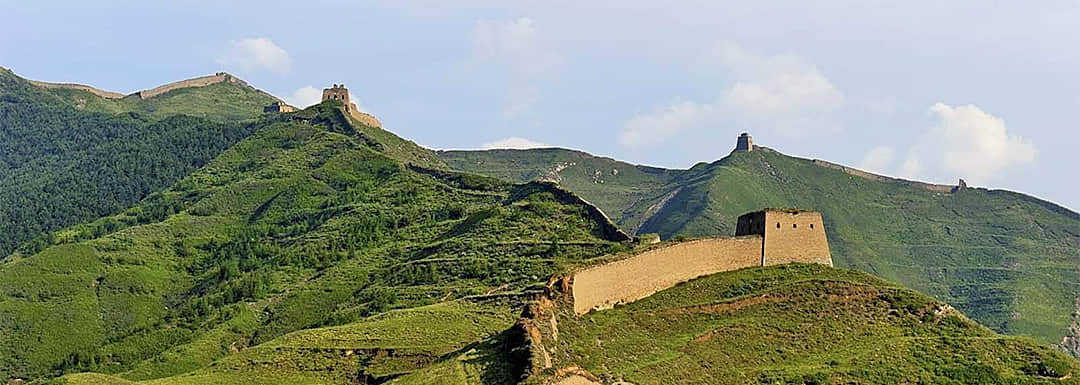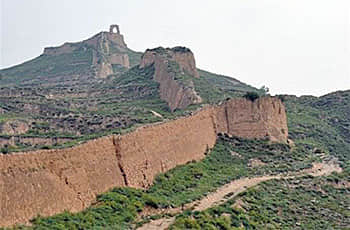Yanmenguan Pass

Yanmenguan Scenic Area is located in the Gouzhu Mountain in the northern part of the ancient city, Daizhou. As it has the central plain to its south and wilderness to its north, Yanmen Pass was an ambitious military defense project in ancient China. Yanmenguan is an important pass on the Great Wall. It is known for its adventurous shape. It is referred to as the first gateway of China or the top pass among all the nine passes. Along with Ningwu Pass and Pian Pass, Yanmen is called one of the three Outside Passes.
- Chinese name: 雁门关 yàn mén guān
- Suggested time: 1 day
- Ticket: April – October: CNY 90, November – March: CNY 60
- Address: Daixian County, Xinzhou City, Shanxi Province, 120 kilometers (75 miles) from Datong City.
- Open hours: 8:00-19:30 (for summer); 8:00-18:00 (for winter)
- Best time to visit: Spring, summer and autumn
- How to get there: Take a long distance bus from Datong Long Distance Bus Station or Datong Xinnan Passenger Station to Daixian County, which cots RMB20-40 and takes 3 hours. You will have to take a local taxi or rent a car to the scenic area at a cost of about RMB100.
Highlights of Yanmen Pass
Yanmen Fortress 

The fortress is located on the ridge platform on the east and west sides of Tieguo Gate. It was established during the Northern Song Dynasty and is a military station. It is also known as "Three Yanmen Fortresses" along with Xixing and Huyu. Protection of the dire pass was crucial.
Guguan Path
This path is also called Gouzhusai (Yanmen) Ancient Path, and has a total length of more than 30 kilometers. It starts in the south from the entrance to Taihe Hill, and leads through Fulagou, Chengshang, Shiqianggou, Wujiayao, Heishiguangou, Tieguomen the high-point, Zhaozhuang, Baicaokou, and Liulin, and stops at Youfang. At present, the ancient path is well preserved. Paved stones form the path. There are a great many twists and turns as it meanders between cliffs on both sides.
The Pass
This is the ancient north gate of Yanmen Pass. It is also known as Baicao Entrance, which is one of 18 passes along Yanmen. For the one pass, there are two fortresses separately called Taihe and Changsheng. Mountains separate the fortresses. During the Spring and Autumn Period and the Warring States Period, Baicao Entrance connected the north and south of the country. Merchants took to the path through all of the passes. The pass crosses a river, for which there are three pass walls, 6 pass gates, and 6 pass forts. The east and west parts are connected to the Great Wall. Now only one pass gate stands, on which is engraved words such as "dedication to the prosperity of the people and the livestock". The only surviving forehead plaque is engraved with the words: "Monkey Ridge".
Monkey Ridge Great Wall
Monkey Ridge got its name from the stones that look like monkeys on the cliffs. The Great Wall meanders along like a dragon. It was restored as part of the ancient wall by Governor Li Jingyuan in 1605 CE. Three layers of bricks were used to build the top, on which horses can walk, and was built on the site of the ancient Great Wall. Existing buildings that counter enemies from Baicao Entrance to Xin Guangwu such as “Zhendong”, “Wa’e”, “Zhuanglu” and “Tianshan” are well preserved. In addition, there are beacon towers and giant gaps excavated. Those are all masterpieces from the Ming Dynasty.
Tianxian Gate and Yan Lou
Tianxian Gate is the east gate of the Guan Pass and its name is engraved on the plaque in seal characters (ancient style of writing). Parapets are set along the wall. There is one plank for the door and blue stones are used to pave the road. Yan Building is set on the Tianxian Gate, facing west. There are 5 rooms in one row and four in another. Corridors surround Yan Lou. For the cross-top building, the front chamber is the separation gate. The top rooms are made of bricks, as are all the parts except for the two round windows. The flat slab is covered with a bucket arch, forming an upturned shape. The roof is covered with gray tiles, and the two sides of the ridge are set with auspicious beasts. Four wind chimes are hung at the four corners.
Drop us a line and we'll connect you with the top China expert in no time!